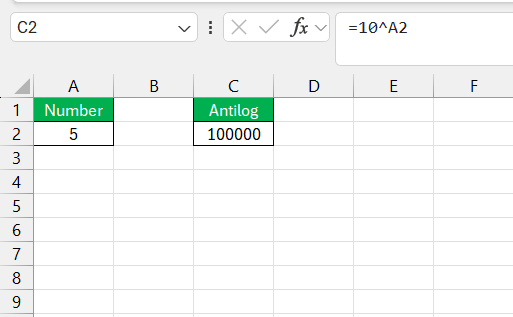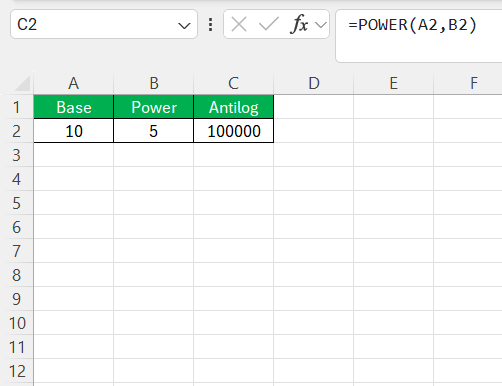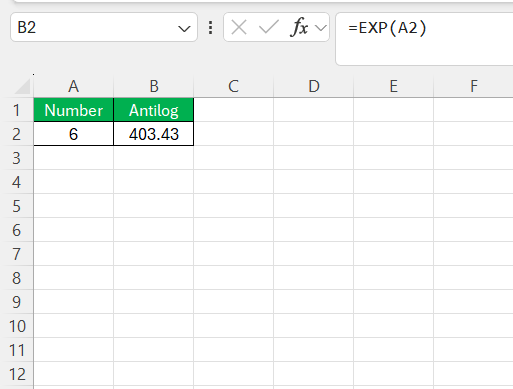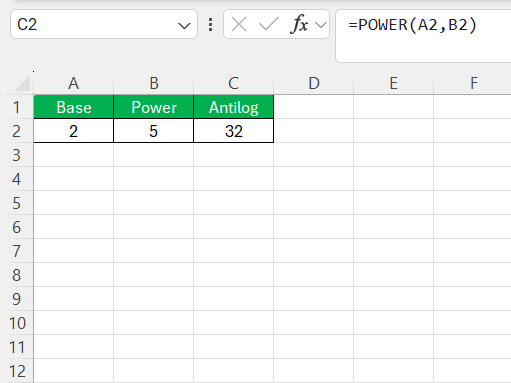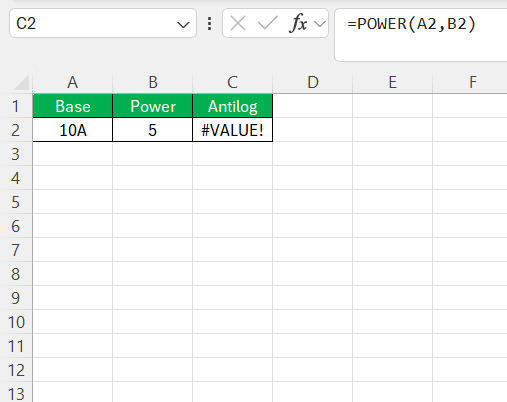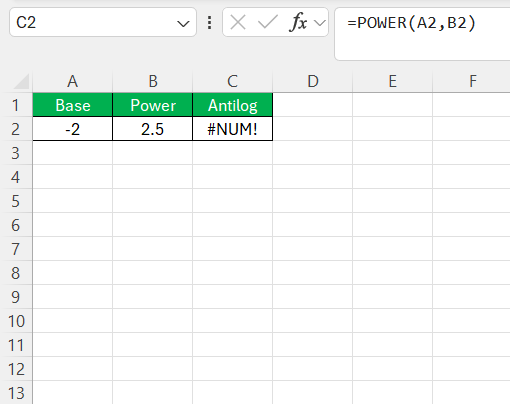In this article, I’ll walk you through calculating the inverse of log, often referred to as an “antilog,” in Excel. This can be particularly helpful when working with data transformed through logarithmic functions, such as those commonly seen in financial modeling, scientific research, or statistical analysis. Let’s break down the process step by step so you can apply it to your own work.
Key Takeaways:
- The antilog, or inverse of log, helps reverse logarithmic transformations, restoring data to its original form.
- In Excel, use the formula
=10^A2for base 10 antilogs or=POWER(base, exponent)for other bases. - For natural base (e) antilogs, use
=EXP(cell)to simplify the calculation. - Common errors with antilog formulas include non-numeric inputs and negative values, which can be avoided with careful data checks.
- Excel’s flexibility with different bases makes it ideal for applying antilogs in fields like finance, science, and data analysis.
Table of Contents
Understanding Antilogs: Back to Basics
Defining the Concept of Logarithms
When we talk about logarithms, we’re looking at a way to express numbers as the power of another number—known as the base. It’s a transformative tool that simplifies complex calculations; imagine shrinking a vast universe into a comprehensible world map.
For instance, a logarithm can take a mammoth number like 100,000 and represent it compactly as 5, given the base 10. It’s the mathematical equivalent of a space-saving fold in origami. The beauty lies in the relationship between the base and the number: if a base, say 10, is raised to the power of the logarithm, such as 5, we end up with the original number, which is 100,000 in this case.
The Role of Antilogs in Mathematics
Antilogs act as the great revealers in the world of mathematics, bringing hidden numbers into the light. If logarithms are about understanding ‘how many times one number must be multiplied by itself to achieve another number’, then antilogs are the process of reversing this operation. They provide the answers to the questions posed by logarithms.
In essence, where a logarithm asks, “To what power must our base be raised to yield this number,” the antilog responds, “Here is the number that our base was raised to that power to produce.” They are two sides of the same coin, a perfect dance of cause and effect in numerical form.
It’s like having a secret coded message where the logarithm is the code, and the antilog is the key to deciphering it, returning us to the original number that was masked by the logarithmic process. This fundamental interplay between logs and antilogs is foundational in fields such as acoustics, and electronics, and in analyzing exponential growth and decay processes in biology and other sciences.
Essentially, without antilogs, logarithms would be a one-way street, but with them, we have a thoroughfare of numerical understanding.
Step-by-Step Guide to Inverse of Log in Excel
Method 1 – Using a Simple Formula
Calculating the antilog in Excel can be straightforward using a simple formula. To find the antilog of a number, I use the exponentiation operation. Excel’s built-in exponentiation operator (^) provides the quickest way to perform this task. For instance, if I want to calculate the antilog of a number in cell A2 concerning base 10, I simply type the following formula into a neighboring cell: =10^A2.
As soon as I hit Enter, the antilog appears. This method harnesses the intrinsic rule of antilogs: to reverse a log calculation,
I use the base (10 in this case) raised to the logarithmic value. It’s incredibly efficient for handling common antilog computations with base 10, which are prevalent in various scientific and engineering contexts.
Method 2 – Using the POWER Function
Another robust method within Excel for antilog computations involves the POWER function, which is designed to raise any number to a specified power. This method offers utility beyond the base 10 scenarios, allowing me to calculate the antilog for any base.
To employ this method, I start by selecting the cell where I wish to display the antilog. Then I enter the formula =POWER(base, exponent), where
- ‘base’ is the cell containing the base value
- ‘exponent’ represents the cell with the logarithmic value.
For example, to find the antilog of a log value, with a base value in A2, I input =POWER(A2,B2) and press Enter.
This approach is versatile and extendable to any base, not just 10 or e (the Euler’s number), thus supplementing Excel’s capabilities in addressing a wider range of scientific and mathematical calculations. It’s powerful, precise, and a testament to Excel’s adaptability.
Practical Examples and Excel Tips
Calculating Antilogs for Different Bases
Antilogs aren’t confined to the commonly assumed base 10. Sometimes, I find myself needing to calculate antilogs with different bases, such as e (the natural logarithm base) or 2 (often used in information theory and computing). Excel capably handles these varied bases using the same techniques I’ve mentioned earlier.
For example, with a logarithmic value in cell A2 and a base of e, I would use the EXP function in Excel, which implicitly uses e as the base. The formula: =EXP(A2) entered into cell B7 will quickly give me the antilog.
When dealing with a base other than 10 or e, the ‘POWER’ function steps up to bat. If I have a base of 2 and the logarithmic value in cell B2, I simply enter =POWER(A2, B2) into another cell to get the antilog.
Whether it’s for understanding binary systems or natural growth processes, Excel has the flexibility to switch bases with ease for any antilog calculation I require.
Troubleshooting Common Antilog Errors in Excel
Working with antilogs in Excel, I encounter errors from time to time which can often be attributed to a few common mishaps. The “#VALUE!” error is typical when the input in the log cell is non-numeric because, naturally, Excel requires numerical inputs to perform mathematical operations.
To resolve this, I check the cell for any non-numeric characters and correct them.
Another error, “#NUM!”, arises when negative values are used in an antilog function, which is mathematically impossible as there is no real solution.
Here, I reassess the dataset to ensure all logarithmic values are appropriate for the antilog calculations.
I sometimes notice that incorrect results – not outright errors – appear due to incorrect formula inputs or referencing errors, where a wrong cell or base is used. Diligent proofreading of the formulas often nips this issue in the bud. Moreover, understanding the limitations and proper usage of functions like POWER and EXP aids in the prevention of errors, ensuring smooth sailing through the sea of numerical analysis in Excel.
Careful formula entry and attention to the mathematical rules of logs and antilogs keep my worksheets error-free and reliable.
FAQ on Inverse of Log in Excel
How do I find the inverse of log?
To find the inverse of log, or antilog, in Excel, use the POWER function with syntax =POWER(base, logarithm). Replace ‘base’ with the base number and ‘logarithm’ with the logarithm of the number. For instance, if the base is 10 and the logarithm is in cell A1, input =POWER(10, A1). This will give you the original number.
What exactly is an antilog, and how does it relate to logarithms?
An antilog is the inverse function of a logarithm. It is used to determine the original number before it was transformed by the logarithmic function. If you take a logarithm of a number, the antilog of that result will bring you back to the original number. For instance, the antilog of log10(100) is 100 because 10 to the power of 2 is 100. They are two interdependent functions that essentially undo each other’s operations.
Can you calculate antilogs for bases other than 10 in Excel?
Yes, you can calculate antilogs for bases other than 10 in Excel. Use the POWER function for any base, with the syntax =POWER(base, exponent), or use the EXP function specifically for the natural base e. Thus, Excel provides flexibility to work with various bases for antilog calculations.
How can I use Excel’s antilog functions for real-world data analysis?
Excel’s antilog functions are useful in real-world data analysis for reversing logarithmic transformations. This is valuable when analyzing data on logarithmic scales, such as seismic activity on the Richter scale or financial growth over time. By applying antilog calculations, you can revert log-transformed data back to its original scale, facilitating easier interpretation and comparison. This versatility makes Excel an indispensable tool in various analytical fields.
Are there any limitations to be aware of when calculating antilogs in Excel?
While calculating antilogs in Excel, be aware of the following limitations: Excel cannot directly calculate antilogs for negative values or zero, and the accuracy of the calculation may be affected by Excel’s floating-point precision. Additionally, for large numbers, the result may exceed Excel’s capability. Understanding these constraints ensures more reliable use of Excel for antilogs.
John Michaloudis is a former accountant and finance analyst at General Electric, a Microsoft MVP since 2020, an Amazon #1 bestselling author of 4 Microsoft Excel books and teacher of Microsoft Excel & Office over at his flagship MyExcelOnline Academy Online Course.

